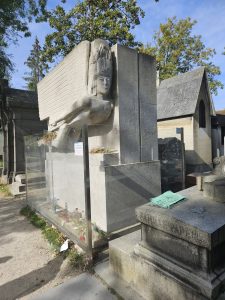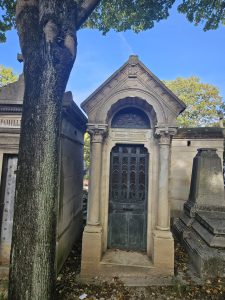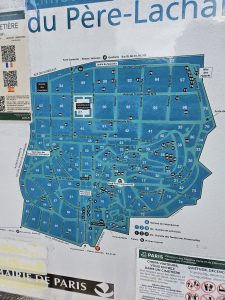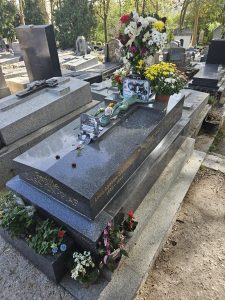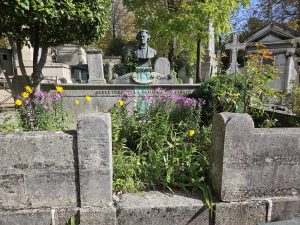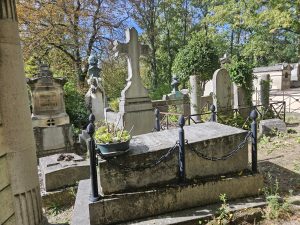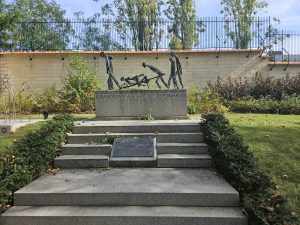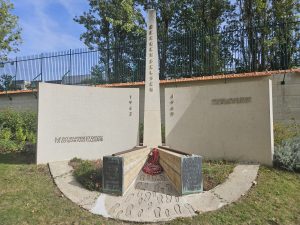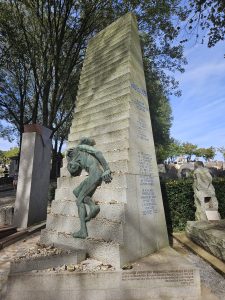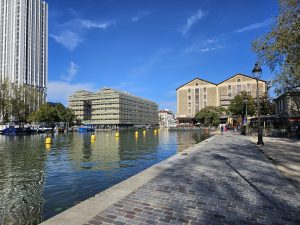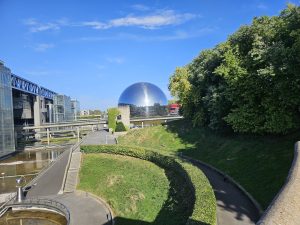Jean-Bernard grimaces as he tells me it’s gonna be hot. Thirty-two degrees. He wrinkles his nose. I already know. Weather.com says 78 ° F by early afternoon. “Je déteste la chaleur,” I respond. “Moi aussi,” he agrees. He doesn’t like the heat, either.
It’s Not 1999 Anymore
Dan and I visited Cimitière Père Lachaise in 1999. I don’t remember much about that excursion except that lipstick kisses covered the Oscar Wilde monument and little of the cemetery occupied flat ground. We found a few prominent residents but there was no map we could find, certainly no cell phone to fall back on.
My start wasn’t promising. I found the first person on my list, the painter Gustave Caillebotte. Took a picture and looked at the mess that passes for a map. It’s the same style map that I used at Montparnasse but Père Lachaise is infinitely more complicated. So I went analog.
I listed my targets, both their personal number and the number of the area where they might be found. Then I arranged people by area, then listed the areas in the sequence that made the most sense starting where I was at that point. From there I was able to find most of the stars in my firmament.
Pen and paper. Don’t leave home without it.
Treasure Hunt
Isabelle, whom I met at the Cimitière des Chiens in Asnières, mentioned that teachers brought groups to PL and assigned them treasure hunts. The kids were to find individuals who were important in some subject area. The First Republic and the First Empire, for instance. Or culture in the 20th century. Or whatever.
I am not unsympathetic. It is a way to impress the reality of the existence of such historical actors on children and embed them in memory. At the same time, it confirms that the names are prizes more than anything. Prizes in a tourist treasure hunt more than anything else.
Still, I’d like to think that every single person in every cemetery everywhere means something more than that.
Tricks of the Search
Some—Honoré de Balzac, Marcel Proust, Eugène Delacroix—sit on the walkways and are easy to find. Others are more of a challenge. Marie Laurencin, Edith Piaf, Amédéo Modigliani, and others hide away amid tombs that look similar. But one carries a cell phone for a reason.
I googled Laurencin; if I knew what I was looking for, maybe I’d be able to find it. Sure enough. The distinguishing features of a marker, nearby shrubbery, distinctive structures in the background narrow the search area. Bingo!
The system worked particularly well for Modigliani. I could see several people perusing the terrain. We all looked at the picture on my phone, looked for the bush hanging over the grave and a red stone cross atop a tombstone with little columns in the background. And there he was.
Friends in Life and Death
Certain people go together. Jean-Louis-Dominique Ingres, Camille Corot and Honoré Daumier rest adjacent, close in death as they were in life. Corot, a man of independent means was a generous spirit and known as “Papa Corot.” Daumier struggled, surviving on his biting sociological lithographs and aspiring to be a painter. Corot looked out for Daumier, at one point buying Daumier’s home for him so that he and his family would not be homeless. Here, Daumier has a modest site just behind the space allocated to “Famille Corot.” Still friends and neighbors.
Ingres is just a few steps from Section 24 in Section 23. This is where I would want to be. Quiet, nearly silent except for the birds and bugs, forested, cool, a truly “fine and private place.” For all his acclaim, his lionization as the great neoclassicist and master of 19th century French art, his marker is modest. I did, however, recognize him right away.
We Will Never Forget
I knew a string of numbered monuments fell along the peripheral road at the side of area 97. It was not until I got there that I discovered this entire section is dedicated to the victims, the heroes, the dead, the survivors of the Nazi atrocities of World War II.
Heart-wrenching sculptures, even more horrifying words stating the cruelest of facts. One after another, one death camp after another, one set of executions after another, one more piece of evidence after another that we must not ever forget even the smallest detail of what happened then.
I am sure I should have known that this might, for our times, be the most important corner of Père Lachaise. It isn’t about the romantic decay of almost two hundred years of commemorating the famous, infamous and unknown. It is all about the criminal global enterprise undertaken by the evilest cabals of modern times.
That evil is something we must forever keep at the forefront of our minds.
Counting Steps
Just how far does one walk, on average, in an hour? Apparently, a brisk walk will move you five miles, a lazy amble a mile or so. My explorations are of a stop-and-go nature. So perhaps two or two and a half miles? Père Lachaise is also very up and down; does that make a difference? Three hours’ perambulations might be six or seven miles?
I gotta get me a pedometer.
Turned Around
The plan was to take the Métro to Stalingrad and then walk back to the hotel along the Canal Saint Martin, reversing the stroll I took on my first night. It was a good idea not well executed.
I turned 180 degrees in the wrong direction, following instead Le Bassin de la Villette along the Quai de la Loire. Around the time I came upon massive red constructions and an unfamiliar green space, it occurred to me that I wasn’t in the Tenth anymore. Sure enough, Parc de la Villette. I checked Google Maps for the location of the nearest Métro stop, hung a left past the Cité des Sciences et de l’Industrie with it’s marvelous Géode, and back underground at the Porte de la Villette.
If I had walked the right way, it would have been another mile and a quarter. La Villette.
Last Supper in Paris
No better dinner than the mirabeille ice cream I found at Sucré Glace. A short walk down Marseilles returned me to my neighborhood wine bar and eatery, Mems. It’s where the youngsters seem to hang out. There and at du Pain et des Ides, the boulangerie-patisserie across the street.
Two glasses of sauvignon Blanc were the perfect dessert to my last supper of ice cream.
It would be an early morning were I to get to Charles de Gaulle in ample time for my 10:40 flight to Stockholm, changing to a flight to Vilnius. I am off to bed.
Au Revoir, Paris

